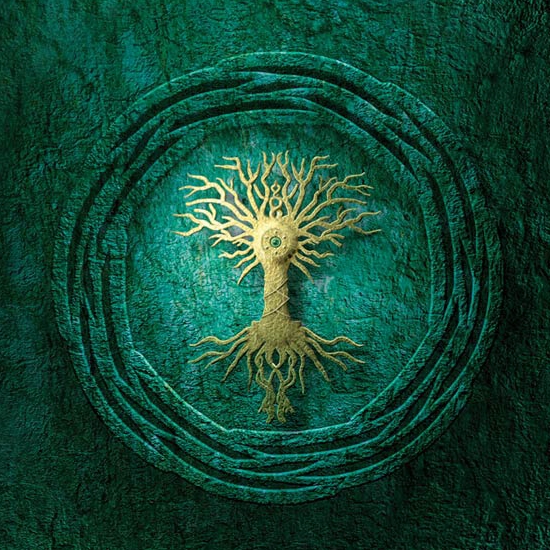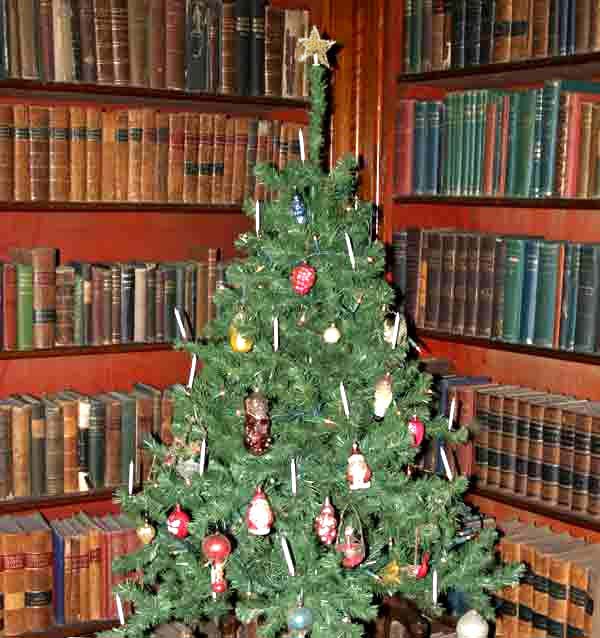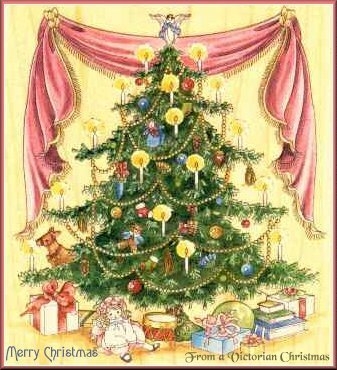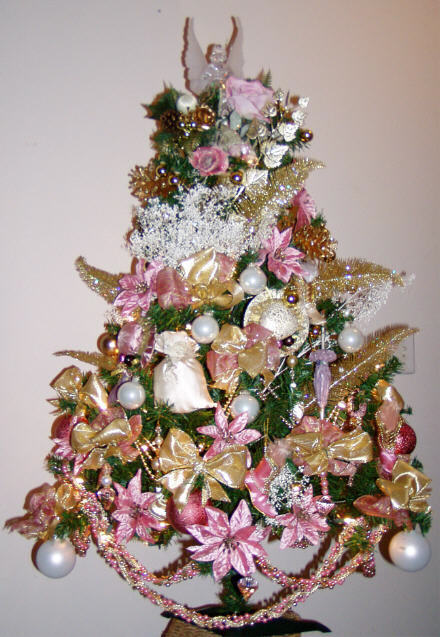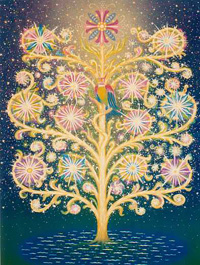|
The Tree of Life |
||||
|
||||
|
Pagan Tree of Life Symbol .
Yule trees go way back in Pagan tradition, and generally were outdoor live trees that were decorated with hanging candles. The Yule tree lights and ornaments originally symbolized the sun, moon and stars as they looked on the Tree of Life. The Yule tree decorations also represented the souls of the departed who we remember at the end of the year. And then there is the modern day gift giving which originated from hanging sacred presents on the Yule tree as offerings to deities such as Attis and Dionysus. And to think all of this sprung from the pine groves equated with the Great Mother Goddess Another custom dating back to Pagan roots is
the burning of the Yule log. Originally the Yule
bonfire was meant to give renewed life and power to
the sun, thus the sun was reborn with the shortest
day marking the time of year when the days started
becoming longer. Traditionally Yule logs are oak,
with the oak tree symbolizing the Cosmic Tree of
Life, per Druid lore. Pine is also used to represent
the dying Gods Attis, Dionysus and Woden.
|
||||
|
The Christmas Tree
Editors Note: The following article is a Christian viewpoint and you can read the rest of the article HERE to see it explained in context. For our purpose we merely wish to show the true origin of the "Christmas Tree" or "Yule Tree". As Pagans have considered the "World Tree" or the "Tree of Life" as representative of their universe for thousands of years, it was only natural to use a tree as a symbol for the rebirth as days grow longer again after the Winter Solstice. The end result is that today we see these trees all over the world, used in a festive spirit of peace and joy, and still place a star or aAngel over the top, much as the Ancient Sumerians and Akkadians did over 5000 years ago. {See a good sample here for comparison}. The imagery remains,
though perhaps the meaning and significance has been
lost to many. In the work cited below, it is clear
that at least some Christians understand both the
origin and the meaning, though this particular view
may be a little extreme. The Non-Christian Origins of
Christmas
The Encyclopedia Britannica 1949, article "Christmas", says-- "CHRISTMAS (the 'Mass of Christ') --- Clement of Alexandria (about 200 AD) mentions several speculations on the date of Christ's birth, and condemns them as superstitious --- The exact day and year of Christ's birth have never been satisfactorily settled. When the Fathers of the Church in AD 340 decided upon a date to celebrate the event, they wisely chose the day of the Winter Solstice, which was firmly fixed in the minds of the people, and which was their MOST IMPORTANT FESTIVAL." ( Meaning that the population had already been celebrating a winter festival that was not Christian, ed.) The Encyclopedia Americana 1946, article "Christmas" says the same-- "CHRISTMAS, the 'Mass of Christ'--- In the 5th century the Western Church ordered it to be celebrated forever on the day of the old Roman feast of the Birth of Sol (the Sun)---. Among the German and Celtic tribes, the Winter Solstice was considered an important point of the year, and they held their chief festival of Yule to commemorate the return of the burning-wheel (the sun)." The Catholic Encyclopedia, 1913 Volume III, 1908 by Robert Appleton Company, article on Christmas, clearly defines the origin of the winter holiday date: "The well-known solar feast, however, of Natalis Invicti, celebrated on 25 December, has a strong claim on the responsibility for our (Catholic) December date. For the history of the solar cult, its position in the Roman Empire, and syncretism with Mithraism, see Cumont's epoch-making "Textes et Monuments" etc., I, ii, 4, 6, p. 355. Mommsen (Corpus Inscriptionum Latinarum, 12, p. 338) has collected the evidence for the feast, which reached its climax of popularity under Aurelian in 274." [The Roman "Mass" is a ceremonial offering where Christ is supposedly re-sacrificed weekly at church at the bequest of men priests, while the Bible teaches, "So Christ was once offered to bear the sins of many; and unto them that look for Him shall He appear the second time without sin unto salvation." (Hebrews 9:28) "Christ-Mass" is not Biblical.] So we see that it was not until 340 years after the birth of Christ that the holiday "Christmas" was established by the Roman Catholic Church! The date December 25th has no Biblical origin at all but the date was chosen to satisfy the population which was already holding a pagan winter celebration of the winter solstice when the days began to get longer again. It was a superstitious belief in a return of the "sun god" to Earth, and the feast was called Natalis Invicti. The winter Christmas holiday season was invented to pacify pagans in the Roman Empire and it is a combination of heathen customs, symbols, and rites, along with some Christian Bible verses mixed in for good measure. Christmas is an adulterated superstitious holiday in a "Christian wrapper"! |
||||
|
.
|
||||
| CHRISTMAS
- A Pagan Tradition Catholic Encyclopedia - New Advent The yule log The calend fires were a scandal even to Rome, and St. Boniface obtained from Pope Zachary their abolition. But probably the Yule-log in its many forms was originally lit only in view of the cold season. Only in 1577 did it become a public ceremony in England; its popularity, however, grew immense, especially in Provence; in Tuscany, Christmas is simply called ceppo (block, log — Bonaccorsi, op. cit., p. 145, n. 2). Besides, it became connected with other usages; in England, a tenant had the right to feed at his lord's expense as long as a wheel, i.e. a round, of wood, given by him, would burn, the landlord gave to a tenant a load of wood on the birth of a child; Kindsfuss was a present given to children on the birth of a brother or sister, and even to the farm animals on that of Christ, the universal little brother (Tiele, op. cit., p. 95 sqq.). Greenery Gervase of Tilbury (thirteen century) says that in England grain is exposed on Christmas night to gain fertility from the dew which falls in response to "Rorate Cæli"; the tradition that trees and flowers blossomed on this night is first quoted from an Arab geographer of the tenth century, and extended to England. In a thirteenth-century French epic, candles are seen on the flowering tree. In England it was Joseph of Arimathea's rod which flowered at Glastonbury and elsewhere; when 3 September became 14 September, in 1752, 2000 people watched to see if the Quainton thorn (cratagus præcox) would blow on Christmas New Style; and as it did not, they refused to keep the New Style festival. From this belief of the calends practice of greenery decorations (forbidden by Archbishop Martin of Braga, c. 575, P.L., LXXIII — mistletoe was bequeathed by the Druids) developed the Christmas tree, first definitely mentioned in 1605 at Strasburg, and introduced into France and England in 1840 only, by Princess Helena of Mecklenburg and the Prince Consort respectively. The mysterious visitor Only with great caution should the mysterious benefactor of Christmas night — Knecht Ruprecht, Pelzmärtel on a wooden horse, St. Martin on a white charger, St. Nicholas and his "reformed" equivalent, Father Christmas — be ascribed to the stepping of a saint into the shoes of Woden, who, with his wife Berchta, descended on the nights between 25 December and 6 January, on a white horse to bless earth and men. Fires and blazing wheels starred the hills, houses were adorned, trials suspended and feasts celebrated (cf. Bonaccorse, op. cit., p. 151). Knecht Ruprecht, at any rate (first found in a mystery of 1668 and condemned in 1680 as a devil) was only a servant of the Holy Child. The crib (creche) or nativity scene St. Francis of Assisi in 1223 originated the crib of today by laicizing a hitherto ecclesiastical custom, henceforward extra-liturgical and popular. The presence of ox and ass is due to a misinterpretation of Isaiah 1:3 and Habakkuk 3:2 ("Itala" version), though they appear in the unique fourth-century "Nativity" discovered in the St. Sebastian catacombs in 1877. The ass on which Balaam rode in the Reims mystery won for the feast the title Festum Asinorum (Ducange, op. cit., s.v. Festum). Hymns and carols The degeneration of these plays in part occasioned the diffusion of noels, pastorali, and carols, to which was accorded, at times, a quasi-liturgical position. Prudentius, in the fourth century, is the first (and in that century alone) to hymn the Nativity, for the "Vox clara" (hymn for Lauds in Advent) and "Christe Redemptor" (Vespers and Matins of Christmas) cannot be assigned to Ambrose. "A solis ortu" is certainly, however, by Sedulius (fifth century). The earliest German Weihnachtslieder date from the eleventh and twelfth centuries, the earliest noels from the eleventh, the earliest carols from the thirteenth. The famous "Stabat Mater Speciosa" is attributed to Jacopone da Todi (1230-1306); "Adeste Fideles" is, at the earliest, of the seventeenth century. These essentially popular airs, and even words, must, however, have existed long before they were put down in writing. Cards and presents Pagan customs centering round the January calends gravitated to Christmas. Tiele (Yule and Christmas, London, 1899) has collected many interesting examples. The strenæ (eacute;trennes) of the Roman 1 January (bitterly condemned by Tertullian, de Idol., xiv and x, and by Maximus of Turin, Hom. ciii, de Kal. gentil., in P.L., LVII, 492, etc.) survive as Christmas presents, cards, boxes. SOURCE |
||||
|
The Esoteric Tree of Life New Age
|
||||
| FAIR USE NOTICE: This page contains copyrighted material the use of which has not been specifically authorized by the copyright owner. Pegasus Research Consortium distributes this material without profit to those who have expressed a prior interest in receiving the included information for research and educational purposes. We believe this constitutes a fair use of any such copyrighted material as provided for in 17 U.S.C § 107. If you wish to use copyrighted material from this site for purposes of your own that go beyond fair use, you must obtain permission from the copyright owner. | ||||
|
|
